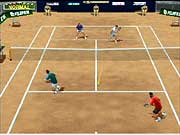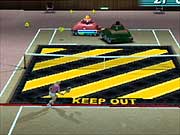Since the untimely passing of the Dreamcast, Sega has been systematically bringing all of its sports titles over to more viable platforms. While its Virtua Tennis series was previously the only tennis game in town, several other publishers have attempted to usurp Hitmaker's excellent tennis series in the time it has taken Sega to carry it over to the PlayStation 2. These games definitely have their merits--but the new Sega Sports Tennis is better looking, has more interesting modes, and features deeper gameplay than the competition. Simply put, console tennis doesn't get any better than this.

The biggest hurdle for most sports games is the fact that you usually need to have at least a passing interest in the sport in question to really get anything out of them. Such is not the case with Sega Sports Tennis. The controls are very straightforward and easy to pick up, though the game by no means forsakes depth for accessibility. Make no mistake--Sega Sports Tennis offers the very definition of arcade-style gameplay. It's fast and it's forgiving, but it's still a skill-based game that will punish you for sloppy play as you start to improve your skills. Using the X, square, and circle buttons respectively for overhand, lob, and slice shots, you have complete control over the speed and altitude of the ball, and when used in concert with the directional control, they allow skilled players to put the ball anywhere on the court.
As in the previous games in the series, the three gameplay modes in Sega Sports Tennis are tournament, exhibition, and world tour. The tournament mode is the most basic arcade-style mode in the game, putting you up against a series of real-world tennis pros. There are a total of 16 different pros to choose from, eight male and eight female. This is the same number of pros as in Tennis 2K2 for the Dreamcast, though the roster has been tweaked slightly, with Jelena Dokic being replaced by Ai Sugiyama.
Exhibition lets you customize and play any variety of singles or doubles matches, either against the computer or with up to three other players. The multiplayer action in Sega Sports Tennis is one of the most compelling aspects of the game, though the computer AI can serve as a challenging but fair opponent as well. The AI consistently demonstrates the right way to play the game, and it does a good job of recognizing and exploiting player weaknesses without seeming overpowered or too cheap. It also does so on a reasonable curve to keep the game from being immediately frustrating. At any rate, it plays smart--if you're riding the net, it will not balk at throwing a lob shot right over your head, and if you're susceptible, it'll lead you to the side of the court and then angle a shot just out of your reach. Even when you're playing alongside the computer in a doubles match, it knows when to take charge of the court and when to back off and let you get some swings in.
The world tour is the deepest of the three gameplay modes, and it's the one you'll probably spend the most time with. After creating your own custom male and female players, you'll travel around the globe, playing a variety of court-based minigames to hone your players' skills and participating in multitiered tournaments. Winning tournaments will net you cash prizes, which can be used to buy new clothes and gear for your players, unlock new courts for use in the exhibition mode, and hire other tennis pros to play alongside you in doubles matches. The world tour mode is great for beginners, as the minigames help teach gameplay fundamentals, and the constantly increasing difficulty level of both the minigames and the tournaments will help keep more experienced players on their toes as well.
At first glance, Sega Sports Tennis looks like a direct port of Tennis 2K2 for the Dreamcast, though there are a few subtle differences worth noting. The clarity and color depth of the textures appear to have been bumped up a notch, and the players' faces are definitely sharper. While it's a minor touch, you'll also notice marks on the court as a match progresses. The game sports some decent lighting, as each player model casts a nice, sharp-looking shadow and the effects of passing cloud cover can occasionally be seen. Probably the most noteworthy aspect of the game's visual presentation is the animation, which looks better than great--it looks completely natural. On the whole, Sega Sports Tennis is a visual improvement on its Dreamcast predecessors, though unfortunately it suffers from some very noticeable and almost distracting aliasing. Still, even with some fairly nasty jaggies, it's easier on the eyes than any of the other tennis games currently available.

Those who played the original Virtua Tennis can attest to the overall quality of its audio, and Sega Sports Tennis carries on the tradition dutifully. The "thwack" of the ball making contact with the racket and the grunts of the players smashing an especially hard stroke resonate satisfyingly. Other smaller touches, like the polite applause of the crowd and the squeak of tennis shoes on the court surface really help put you inside the stadium. Rounding things out is a decent electronic soundtrack that harkens back to the guitar-driven soundtrack of Virtua Tennis, though it can sound a bit sterile and just doesn't have quite the same charm.
It's true that, overall, the differences between Tennis 2K2 on the Dreamcast and Sega Sports Tennis on the PlayStation 2 are pretty minor and ultimately don't amount to all that much. And yet, the end product still shines above the handful of other tennis titles that have cropped up in the interim. If you still haven't stopped playing Tennis 2K2 for the Dreamcast, then you probably won't have much use for Sega Sports Tennis. But for the uninitiated, or those who have simply stopped playing, this is an easy to pick up, hard to put down game that really shines when you're playing it with others.